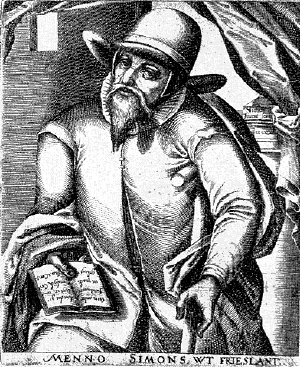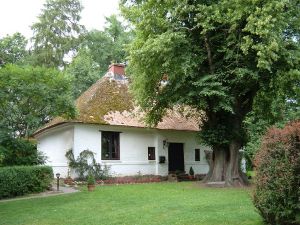Menno Simons
Menno Simons (1496–January 311561) was an Anabaptist religious leader from Friesland (today a province of The Netherlands). His followers became known as Mennonites. Cf. Protestant reformers.
Birth to priesthood
Menno Simonszoon (Simon's son) was born in Witmarsum, Westergo, Friesland. Friesland was ravaged by war in the late 15th and early 16th century. Landsknecht soldiers haunted the Frisian lands in the 1490s to force the 'Free' Frisians to accept the duke of Saxony-Meissen as their head-of-state. The duke was the governor of the Netherlands for the Habsburg family. One of the archenemies of the Habsburgs, the Duke of Guelders invaded Friesland in 1515 and conquered half of it. The other half was ceded by Saxony to the Habsburgers. The Frisians tried to regain their freedom but they were too weak and eventually accepted the imperial authority of the Habsburg emperor Charles V. Simons grew up in this disillusioned and war torn country. Very little is known concerning his parents or his childhood. He was of poor peasant parentage, and his education was limited to his training to become a priest. Ordained as a Roman Catholic priest in 1524 at Utrecht, he was then made a chaplain in his father's village Pingjum.
Theological efforts
Around 1526 or 1527, questions surrounding the doctrine of transubstantiation caused Menno to begin a serious and in-depth search of the scriptures, which he confessed he had not previously studied, even being a priest. At this time he arrived at what some have termed an "evangelical humanist" position.
Menno's first knowledge of the concept of "rebaptism", which he said "sounded very strange to me", came in 1531. This came through the means of hearing of the beheading of Sicke Freerks Snijder at Leeuwarden for being "rebaptized". A renewed search of the scriptures left Menno Simons believing that infant baptism is not in the Bible. He discussed the issue with his pastor, searched the Church Fathers, and read the works of Martin Luther and Heinrich Bullinger. While still pondering the issue, he was transferred to Witmarsum. Here he came into direct contact with Anabaptists, preaching and practicing adult baptism. Later, some of the Münsterite disciples came there as well. While he regarded them as misled and fanatical, he was drawn to their zeal and their view on the Bible, the Church, and discipleship. When his brother Pieter was among a group of Anabaptists killed near Bolsward in 1535, Menno experienced a spiritual and mental crisis. He said he "prayed to God with sighs and tears that He would give to me, a sorrowing sinner, the gift of His grace, create within me a clean heart, and graciously through the merits of the crimson blood of Christ, he would graciously forgive my unclean walk and unprofitable life…"[1]
Menno Simons rejected the Catholic church and the priesthood in January of 1536, casting his lot with the Anabaptists. His date of baptism is unknown, but by October of 1536 his connection with Anabaptism was well-known. In that month Herman and Gerrit Jans were arrested and charged with having lodged Simons. He was probably baptized not long after leaving Witmarsum in early 1536. He was ordained around 1537 by Obbe Philips. Obbe and his brother, Dirk Philips, were among the peaceful disciples of Melchior Hoffman (the more radical having set up the kingdom in Münster). It was Hoffman who introduced the first self-sustaining Anabaptism to the Netherlands, when he taught and practiced believers' baptism in Emden in East Frisia.
Menno evidently rose quickly to become a man of influence. Before 1540, David Joris, an Anabaptist of the "inspirationist" variety, had been the most influential leader in the Netherlands. By 1544, the term Mennonite or Mennist was used in a letter to refer to the Dutch Anabaptists.
Twenty-five years after his renunciation of Catholicism, Menno died at Wüstenfelde, Schleswig-Holstein, and was buried in his garden. He was married to a woman named Gertrude, and they had at least three children, two daughters and a son.
Menno Simons influence on Anabaptism in the Low Countries was so great that Baptist historian William Estep suggested that their history be divided into three periods: "before Menno, under Menno, and after Menno". He is especially significant in coming to the Anabaptist movement in the north in its most troublesome days, and helping not only to sustain it, but also to establish it as a viable Radical Reformation movement.
Quotes
- "True evangelical faith cannot lie dormant. It clothes the naked, it feeds the hungry, it comforts the sorrowful, it shelters the destitute, it serves those that harm it, it binds up that which is wounded, it has become all things to all people."
- "The regenerated do not go to war, nor engage in strife. They are children of peace who have 'beat their swords into plowshares and their spears into pruning forks, and know no war' (Isaiah 2:4, Micah 4:3). ... Our weapons are not weapons with which cities and countries may be destroyed, walls and gates broken down, and human blood shed in torrents like water. But they are weapons with which the spiritual kingdom of the devil is destroyed. ... Christ is our fortress; patience our weapon of defense; the Word of God our sword. ... Iron and metal spears and swords we leave to those who, alas, regard human blood and swine’s blood of well-nigh equal value."
- "We who were formerly no people at all, and who knew of no peace, are now called to be ... a church ... of peace. True Christians do not know vengeance. They are the children of peace. Their hearts overflow with peace. Their mouths speak peace, and they walk in the way of peace."
Notes
- ↑ Menno Simon's Renunciation of the Church of Rome. Retrieved 2007-04-13.
ReferencesISBN links support NWE through referral fees
- Dutch Anabaptism: Origin, Spread, Life and Thought (1450–1600), by Cornelius Krahn
- The Anabaptist Story: An Introduction to Sixteenth-Century Anabaptism, by William Roscoe Estep ISBN 0-8028-0886-7
- The Complete Writings of Menno Simons…, translated by Leonard Verduin and edited by John C. Wenger, with a biography by Harold S. Bender ISBN 0-8361-1353-5
External links
- Menno Simons in Global Anabaptist Mennonite Encyclopedia Online
- Menno Simons. Life, writings, images and links
- Menno Simons Biography from the Church of the Brethren.net
- Dr Victor Shepherd (2001). "Chapter 10: Menno Simons (1496 - 1561)", Witnesses to the Word. Toronto: Clements Pub.. ISBN 189466700X.
Credits
New World Encyclopedia writers and editors rewrote and completed the Wikipedia article in accordance with New World Encyclopedia standards. This article abides by terms of the Creative Commons CC-by-sa 3.0 License (CC-by-sa), which may be used and disseminated with proper attribution. Credit is due under the terms of this license that can reference both the New World Encyclopedia contributors and the selfless volunteer contributors of the Wikimedia Foundation. To cite this article click here for a list of acceptable citing formats.The history of earlier contributions by wikipedians is accessible to researchers here:
The history of this article since it was imported to New World Encyclopedia:
Note: Some restrictions may apply to use of individual images which are separately licensed.

